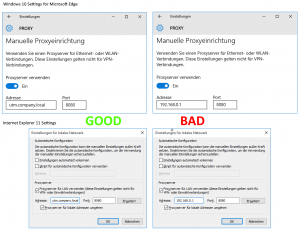I found a very good article about the protocols you can use with your proxy (Sophos UTM or Sophos XG) on windowsitpro.com:
What are the main feature differences between the Windows Kerberos and NT LAN Manager (NTLM) authentication protocols? Why is the Kerberos protocol generally considered a better authentication option than the NTLM protocol?
NTLM is a challenge/response-based authentication protocol that is the default authentication protocol of Windows NT 4.0 and earlier Windows versions. For backward compatibility reasons, Microsoft still supports NTLM in Windows Vista, Windows Server 2003 and Windows 2003 R2, Windows 2000, and Windows XP.
Starting with Win2K, Microsoft implements Kerberos as the default authentication protocol for the Windows OS. This means that besides an NTLM authentication provider, every Windows OS since Win2K also includes a client Kerberos authentication provider.
Table 1, below, compares Kerberos to NTLM, the default authentication protocol of NT 4.0 and earlier Windows versions. The next paragraphs expand on some of the major feature differences (as listed in Table 1) between the Kerberos and the NTLM authentication protocols and explain why generally Kerberos is considered a better authentication option than NTLM.
- Faster authentication. When a resource server gets Kerberos authentication information (in Kerberos speak “tickets” and “authenticators”) from a client, the resource server has enough information to authenticate the client. The NTLM authentication protocol requires resource servers that aren’t domain controllers (DCs), to contact a DC to validate a user’s authentication request. This process is known as pass-through authentication. Thanks to its unique ticketing system, Kerberos doesn’t need pass-through authentication and therfore accelerates the authentication process.
- Mutual authentication. Kerberos can support mutual authentication. Mutual authentication means that not only the client authenticates to the service, but also the service authenticates to the client. Mutual authentication is a Kerberos option that the client can request. The support for mutual authentication is a key difference between Kerberos and NTLM. The NTLM challenge-response mechanism only provides client authentication. In the NTLM authentication exchange, the server generates an NTLM challenge for the client, the client calculates an NTLM response, and the server validates that response. Using NTLM, users might provide their credentials to a bogus server.
- Kerberos is an open standard. Microsoft based its Kerberos implementation on the standard defined in Request for Comments (RFC) 4120. RFC 4120 defines version 5 of the Kerberos protocol. Because Kerberos is defined in an open standard, it can provide single sign-on (SSO) between Windows and other OSs supporting an RFC 4120-based Kerberos implementation. You can download RFC 4120 from the Internet Engineering Task Force (IETF) at http://www.ietf.org. NTLM is a proprietary authentication protocol defined by Microsoft. The NTLM protocol is not specified in an open standard document (for example in an IETF RFC).
- Support for authentication delegation. Thanks to authentication delegation, a service can access remote resources on behalf of a user. What delegation really means is that user A can give rights to an intermediary machine B to authenticate to an application server C as if machine B was user A. This means that application server C will base its authorization decisions on user A’s identity rather than on machine B’s account. Delegation is also known as authentication forwarding. You can use delegation for authentication in multi-tier applications. An example is database access using a Web-based front-end application. In a multi-tier application, authentication happens on different tiers. In such a setup, if you want to set authorization on the database using the user’s identity, you should be capable of using the user’s identity for authentication both on the Web server and the database server. This is impossible if you use NTLM for authentication on every link, simply because NTLM doesn’t support delegation.
- Support for smart card logon. Through the Kerberos PKINIT extension, Win2K and later versions include support for the smart card logon security feature. Smart card logon provides much stronger authentication than password logon because it relies on a two-factor authentication. To log on, a user needs to possess a smart card and know its PIN code. Smart card logon also offers other security advantages. For example, it can block Trojan horse attacks that try to grab a user’s password from the system memory. The NTLM authentication protocol doesn’t support smart card logon.
Table 1: Kerberos-NTLM Feature Comparison
| NTLM | Kerberos | |
| Underlying Cryptographic Technology | Symmetric Cryptography | – Basic Kerberos: Symmetric Cryptography – Kerberos PKINIT (this is the Kerberos subprotocol that supports smart card logon): Symmetric and Asymmetric Cryptography |
| Trusted Third Party | DC | – Basic Kerberos: DC with Kerberos Key Distribution Center (KDC) service – Kerberos PKINIT: DC with KDC service and Windows Enterprise Certification Authority (CA). |
| Microsoft Supported Platforms | Windows 95, Windows 98, Windows ME, NT 4.0, Win2K, XP, Windows 2003/R2, Vista | Win2K, XP, Windows 2003/R2, Vista |
| Features | Slower authentication because of pass-through authentication | Faster authentication because of unique ticketing system |
| No mutual authentication | Optional mutual authentication | |
| No support for delegation of authentication | Support for delegation of authentication | |
| No native protocol support for smart card logon | Native protocol support for smart card logon | |
| Proprietary Microsoft authentication protocol | Open standard |
Source: windowsitpro.com
Browsers like Mozilla Firefox can use the IE settings (configure “Use system proxy settings”. Safari and Chrome are always using the IE settings. Microsoft Edge is using the system settings. Go to the Start Button, Settings, Network & Internet, Proxy and configure your proxy server with your FQDN (ensure that the DNS FQDN hostname is resolvable by all workstations):
I also wrote a tutorial to distribute the proxy settings automatically to your clients: Link









